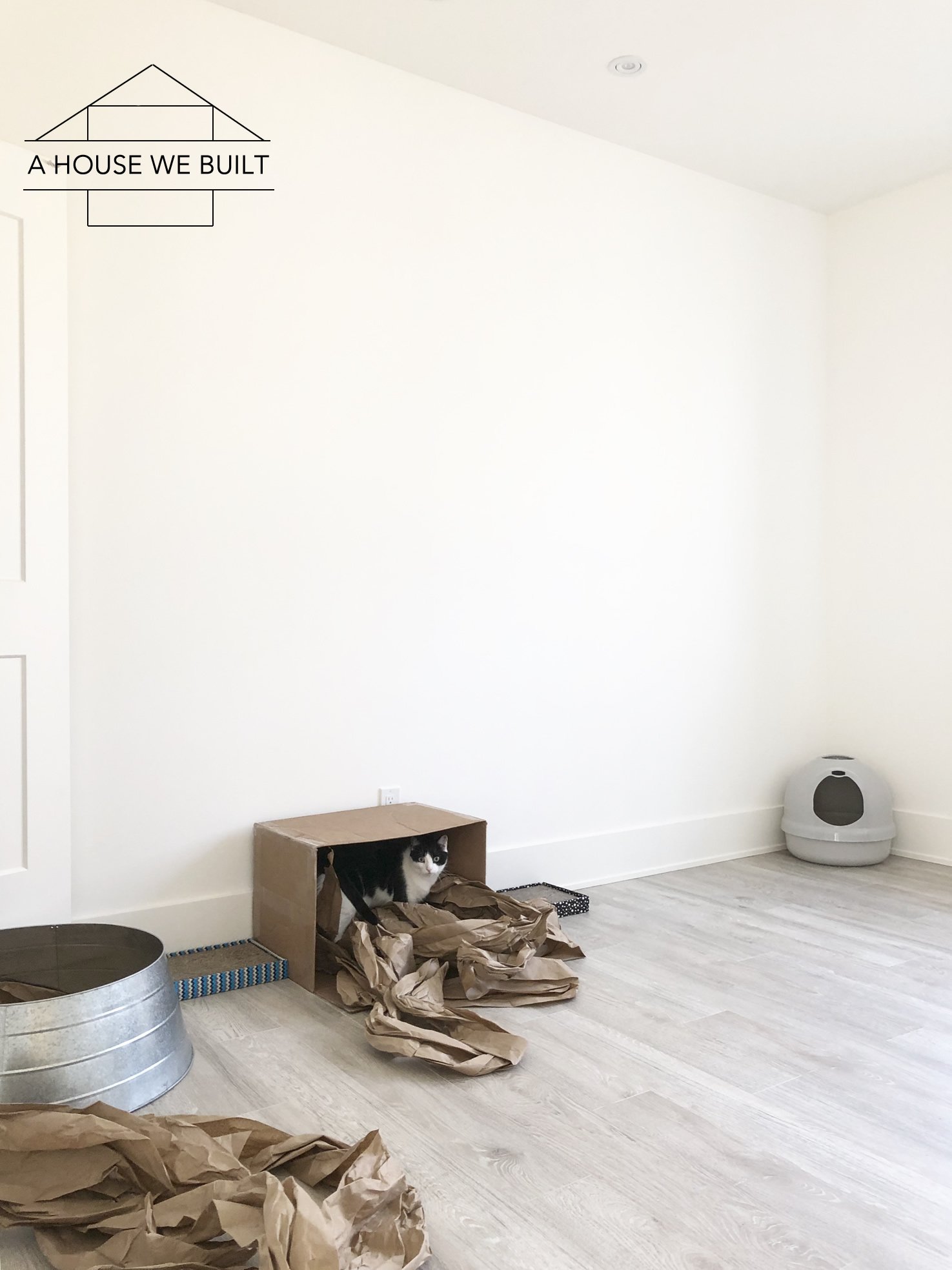
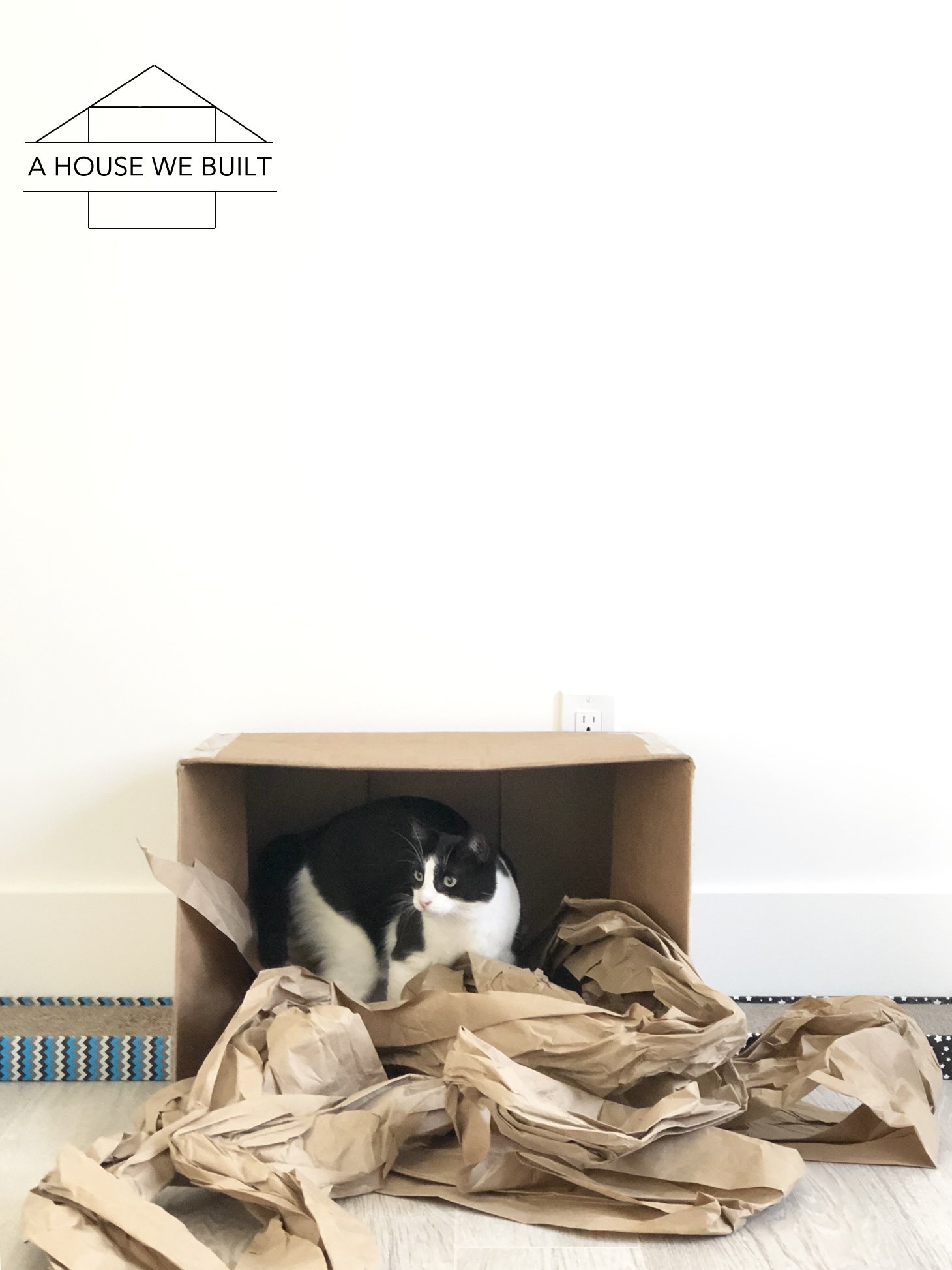
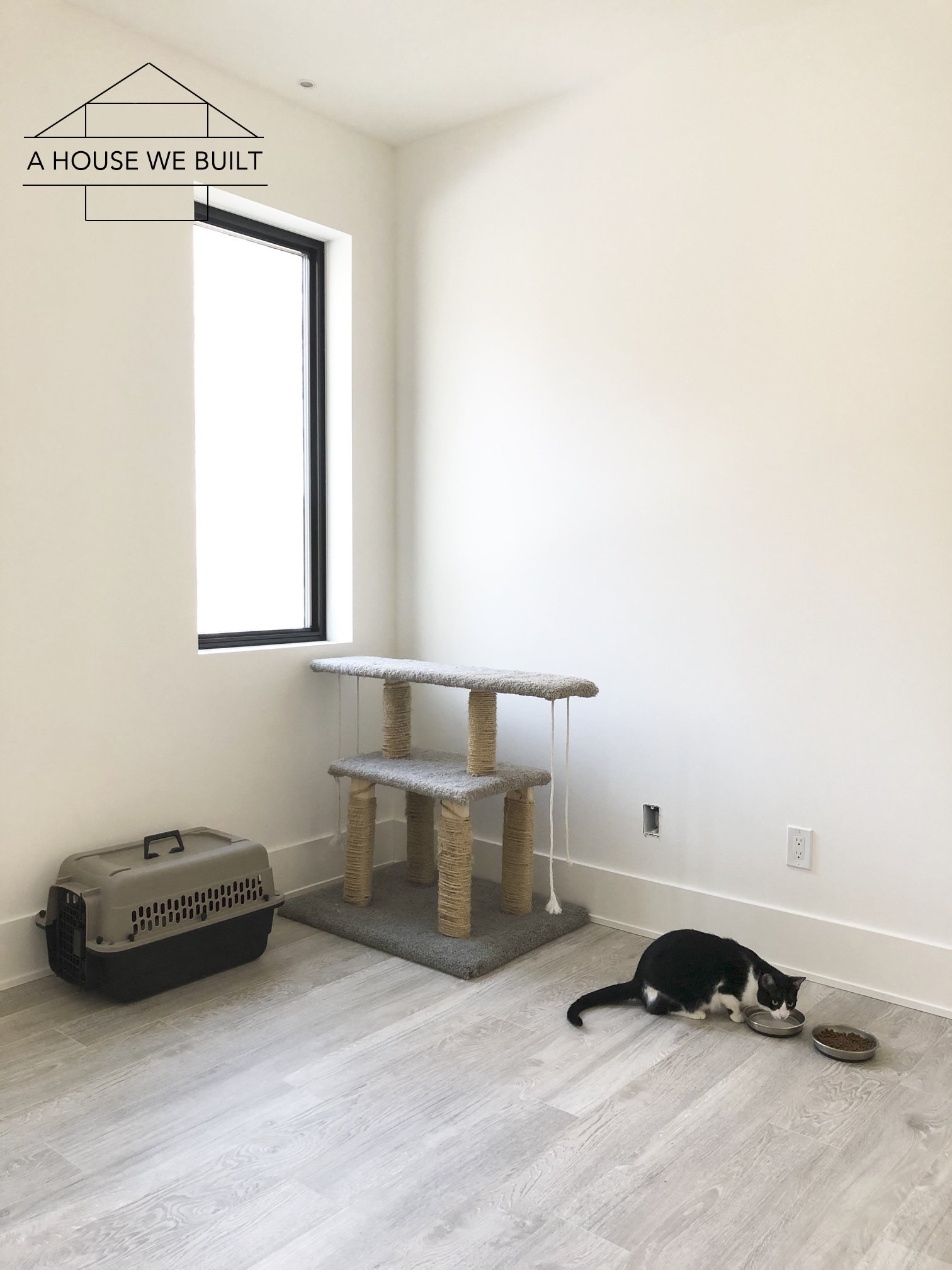
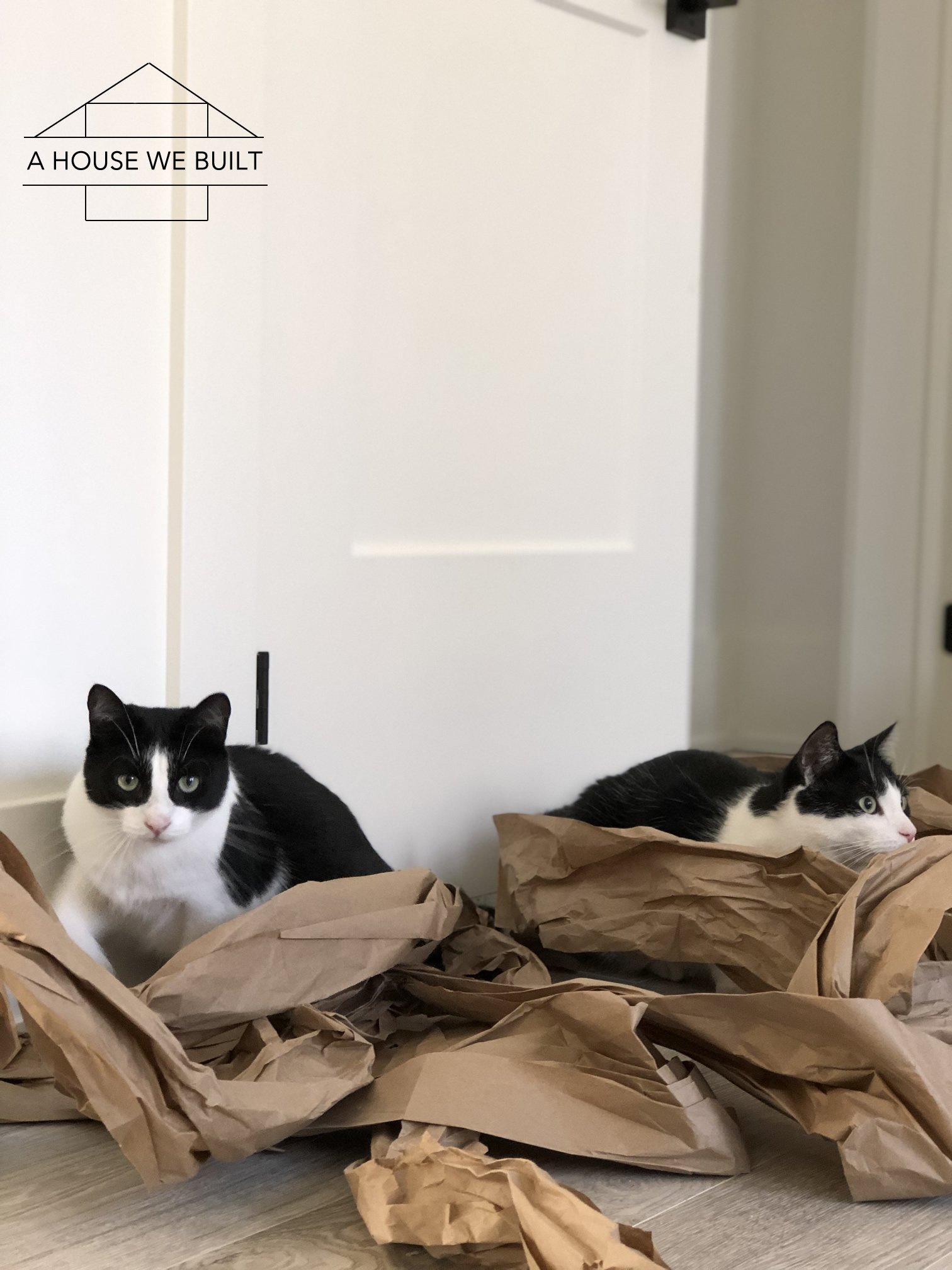
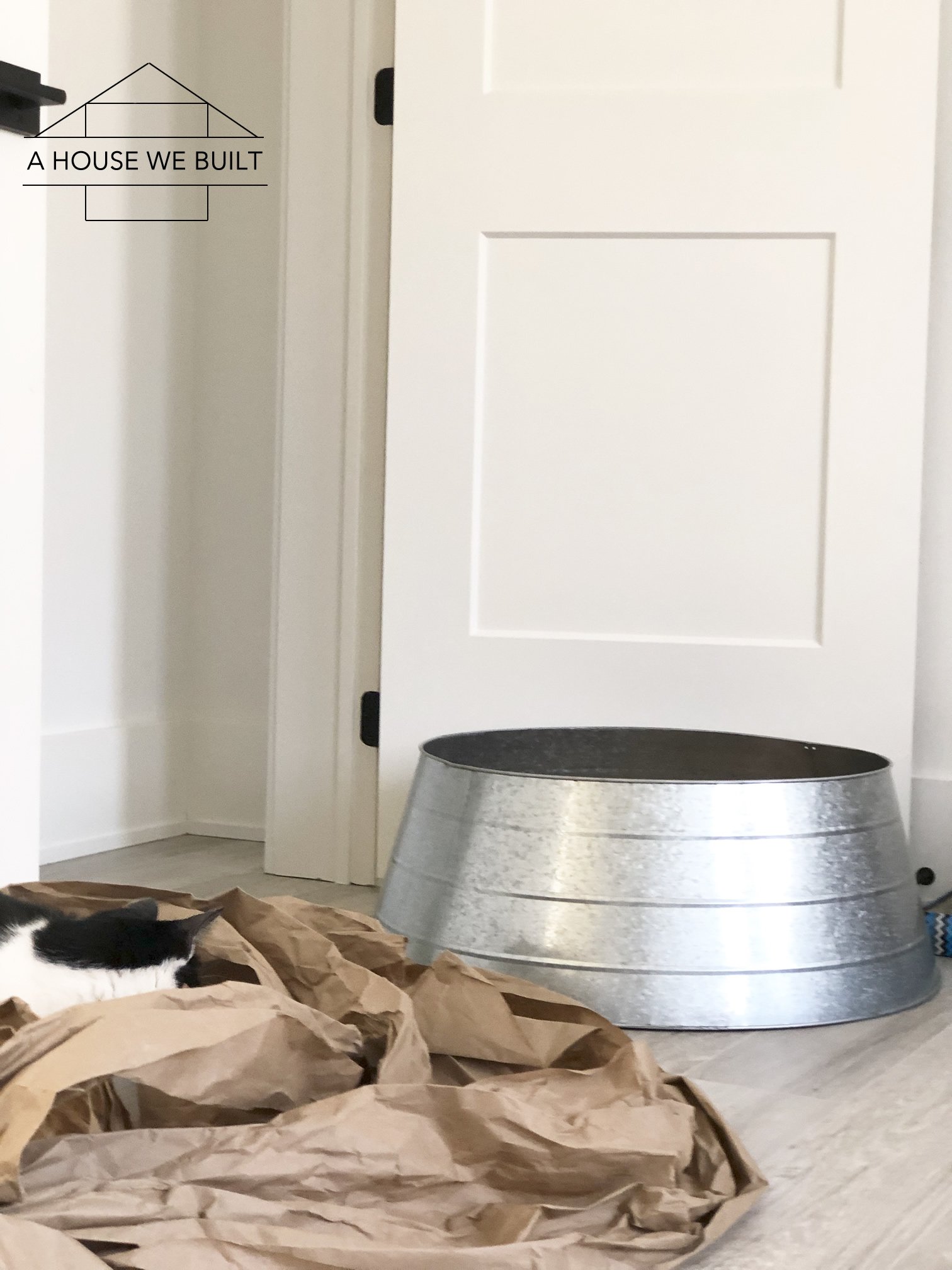
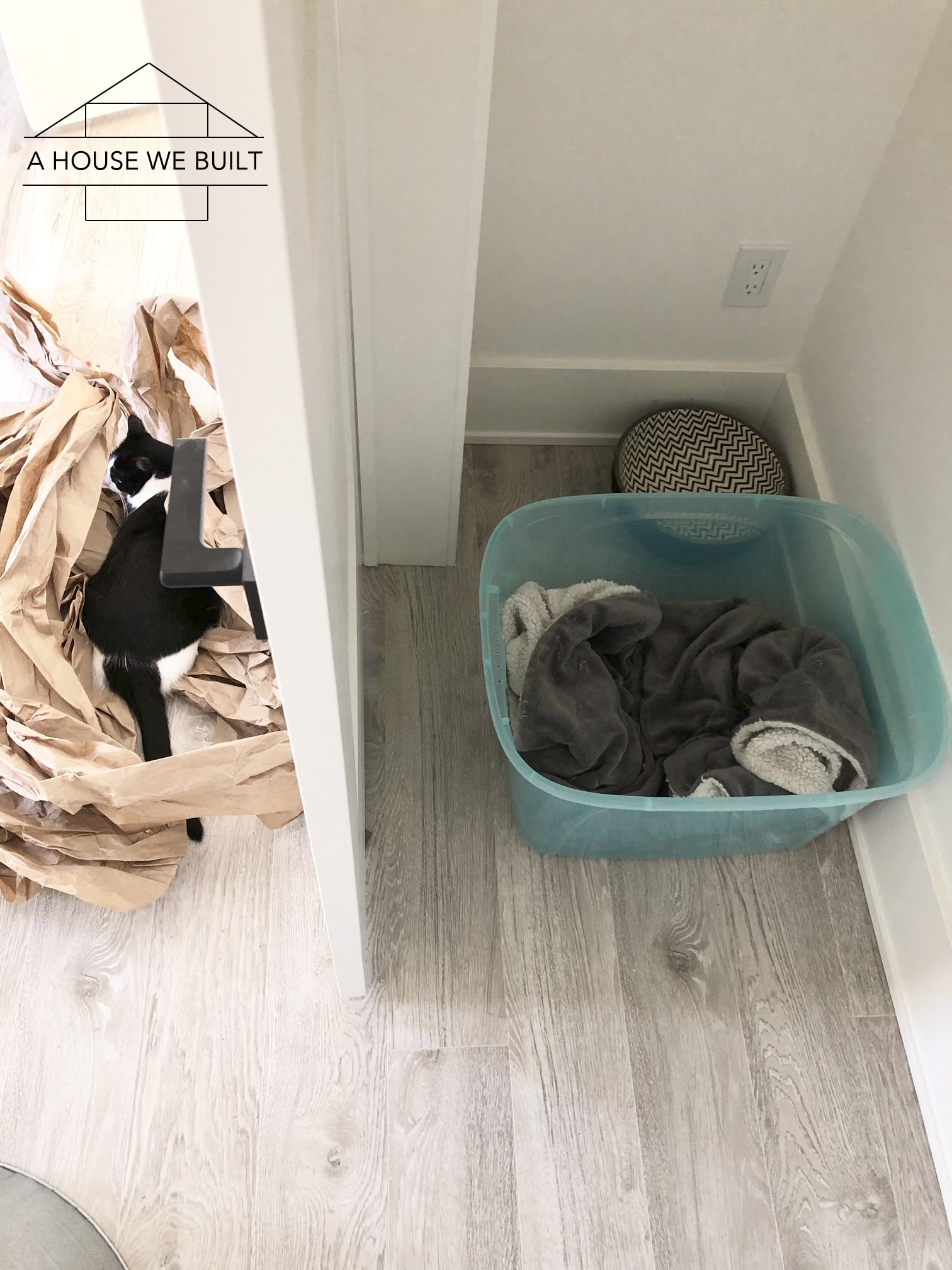
Although our cats have free run of our house all day long, we created a “cat room” where they spend their nights (when we’re either sleeping or away). Their cat room has fresh water and food, a litter box, beds and boxes, scratchers and toys, and everything they love. They all love this room and going here at night has become a part of their routine – they actually go to it of their own accord at night when I call for them.
WHY WE HAVE A CAT ROOM.
When we first moved here, I wanted to help our furry family members acclimatize to our new home so we turned a spare room into a “cat room”. This created a contained environment with all their favorite things to give them a place that smelled and felt familiar to them. For the first day after we moved here, I kept them in this room only to familiarize them with the sounds/smells of our new home without being overwhelmed. Then every day after that I’d let them out short time (with supervision), increasing the time each day to expand their comfort with the new house while giving them a safe, familiar space to return to (which they often did) if they needed reassurance. After about a week, they were fully acclimatized and we gave them free run of our house during the days, though we still return them to their cat room each night.
Since they loved their cat room so much, I decided to keep it set up up as “their” space and I always put them in here at night and/or if we go out (which is rare considering we work from home) because when they’re in their cat room, I know they’re in a safe environment. This also means they can’t get into anything they’re not supposed to when I’m not around, reinforcing our house cat rules and training methods.
Every time I put them in their room (usually at night before bed), I also always give them their soft food at the same time so they love the routine of going to the room and it’s always a positive experience.
NOTE 1: If you are adopting new kittens/cats, keeping them in a separate room for the first day(s) this way is also a good idea. Ultimately the idea is to slowly introduce the new element (whether its cats/kittens to a house, or a house to cats/kittens) to make the transition smooth and stress-free. More details here.
NOTE 2: I did not “decorate” this room — the cats decorated it in a sense because they chose all the things inside it. So I didn’t try to make it look pretty, I just kept it full of all the things they love most.
LITTER BOXES.
This is the litter box we have: white version: Amazon | dark grey version: Amazon | pearl version: Amazon. This litter box style is small, minimal and simple, domed to contain litter spray, and very easy to clean.
- We have one litter box on every floor of our house. It’s very important that litter boxes be easily accessible for the cats (the easier to access, the great chance of preventing accidents) so be sure it’s placed somewhere logical, consistent, and easy for them access. The general rule should be one box on each floor, unless you have a ranch home, then maybe do a few around the house.
- I clean all the litter boxes once a day. Since I scoop the boxes out daily, it takes less than 30 seconds to clean each box. I use a self-clumping litter that sticks to their business as soon as they do it and also eliminates any odor. Ultimately, the cleaner you keep the box, the less odor there is. I don’t use self-cleaning/robot boxes because it’s so easy to clean them in person and also, in my opinion, the litter boxes I chose are visually prettier and more minimal, and also much smaller.
- I don’t try to hide them. Yep, you read that right. I just tuck them into corners where they won’t be noticed. Again, it’s very important that cats are easily able to find their litter boxes, so I keep them easy-to-access and unhidden. I’m not sorry or ashamed of them. The simple fact of life is that everybody poops, even cats. I don’t hide our bathrooms, so I also don’t hide theirs. My way of visually minimizing them is by choosing such a simple and dare I say “pretty” style of litter box (this is the style we have: Amazon) that is both small and a similar color to our walls.
FOOD AND WATER.
We feed our cats an allergen-reducing kibble called LiveClear (link: Walmart | Petco). We have 5 cats and also have cat allergies, so this is one of the many ways we reduce allergies. More details here.
We keep fresh water and bowls of dry kibble always available for them both in their room, and also on the main floor of our house. I free-feed them dry kibble because, since they’ve never known what it’s like to go hungry, none of them overeat and none are territorial around their food.
They also have a continuous water fountain (Amazon | Walmart) in our mudroom – I keep it there because it has a tile floor so it’s easier to clean spills since Chai loves to play in the water with his little paws lol.
Finally, they get 1-2 packs/cans of wet food daily per sibling set. Every time I put them in their cat/kitten rooms, I give them a can of wet food to share between each sibling set so they usually get this at night. But if I put them in their room mid-day for any reason, I give them an extra can then too so the amount they get depends on my need for them to be in their rooms but it averages 1-2 cans/day, per sibling set. Wet food is essentially a treat since their main diet is their kibbles, so since none of our cats are territorial around food or ever actually hungry, they are always happy to share the wet food cans between them.
CARDBOARD BOXES.
The cardboard boxes and shipping paper items in this room rotate all the time depending on what we have on hand at any time. Whenever we get a delivery I put the boxes out for them to play with and if I notice a particular one they really love to play with, then I put it in their room until they get tired of it. This makes sure that they always have something in their room that’s new and different and fun.
Be very careful that you always remove any tape, staples, twine, string, or small bits from anything you give cats to play with. Also, never give them normal paper (like printer paper). I only give them the soft crinkly paper used to stuff shipping boxes, and only if it’s in a large piece so that they don’t eat it.
CAT TREE.
Their “cat tree” was a DIY we built right after we adopted them out of lumber, plywood, and carpet. They love it and play/climb on it all the time and it’s a great place for them to scratch. If you’d rather buy one, here are some options: Amazon | Amazon | Amazon | Amazon | Amazon | Amazon | Amazon | Amazon.
SCRATCHERS.
I keep 2 cardboard scratch pads (this is the one that I like best because it’s so simple: Amazon) in here and have 2 on every floor in our house. They love them and usually opt to scratch these over other things in our house as long as they have access to them. You can also sprinkly cat nip on them for added fun!
CAT CARRIER.
The cat carrier (similar: Amazon | Petco) to the left of the cat tree has a little fuzzy blanket inside and I just leave it open all the time because it’s Mocha’s favorite sleeping spot.
TREE COLLAR.
The metal tree collar (Home Depot) is something we actually never used for Christmas and I was originally intending to return it but Chai fell in LOVE with it so I gave it to them and he loves to sleep inside it. I think he feels like it’s his little castle.
CLOSET.
The closet in this room is Matcha’s favorite sleeping spot. I keep one door permanently shut to create a little nook and the other door open. Inside I have a decorative bowl she loved to sleep in as a kitten and still loves but she kinda can’t fit into it anymore because she’s a big kitty now so I also have a plastic storage bin with a blanket in the closet nook that she inevitably actually sleeps in after realizing the bowl isn’t comfy enough. She picked the storage bin herself from the basement. She just started sleeping in it so I gave it to her. But I leave both the bowl and bin for her because I know she loves them.
KITTY FORT.
This is not not in any of the pictures because I don’t actually have it in their room, but I thought I’d mention it anyways. One of our cats’ favorite toys is this little step-stool (Amazon) simply covered with an old bedsheet. We have one of these stools on every floor of our house for convenience anyways, so all I have to do is cover one of them with a sheet to make the cats’ day! This literally keeps them entertained for hours so I’ll often set it up for them in a random part of the house for them to have fun with. It’s small enough to not cause much visual clutter (plus if you have a white stool and white sheet, it’s a pretty minimal look) and since there are only 2-parts to it, it’s easy to clean up.
HEALTH & SAFETY
- Our cats are spay/neutered. This is best for their healthy and prevents territorial behavior.
- Our cats are indoor only. This is best for their safety and longevity.
- Our cats are NOT declawed! Declawing is an horrific, inhumane, barbaric, out-dated practice that is thankfully banned/illegal in many places. Please never EVER declaw a cat!
More of our cat-related posts:
- Cat-related Sources & Cleaning Tips: click here
- How to Stop Cats from Scratching Furniture: click here
- Cat Training Tips: click here
- How to Introduce New Kittens to Older Cats: click here
- How to Cope with Cat Allergies: click here
- Cats & Decor Tips: click here
Angie Dei Tigli says
I love that you have a tab on your website just on the cats’ accommodations in the house❤️
admin says
Lol! We’ll I get a lot of questions about it so figured they may as well get a feature 😀
Joi says
I think your house and tips are really interesting but for me the best thing about your page is the cat tips. They are very helpful. Thanks!
admin says
Glad they’re helpful!
Jennifer says
So happy I found your page! I love your home and all of the cat baby tips! I’m sorry if you mentioned it, because I may have overlooked it. But, what litter do you use?
admin says
Welcome! It’s just a clumping litter that’s non-scented. I don’t remember the brand offhand but it’s nothing fancy. 🙂
Barbara Brinklow says
Your tips for cats are amazing! I just ordered a few items you mentioned. I had 2 feral kittens spayed and they go in and out everyday. The love being indoors but like the yard too. We have a heated kitty house on our porch for them. During the day they stay indoors alot. They use the bathroom outdoors.
I have a senior dog who’s not real fond of them but it’s getting better.
I follow you on Instagram and love all your posts💗
admin says
I’m glad they’re helpful! Best of luck with your new rescues. Sounds like they’re in great hands 🙂
Lesley Hahn says
Thank you so much for sharing! We love your home! I appreciate your tips for kittens snd cats. We are in the process of a new build. We are also excited to add a few sweet kittens to our family. Mahalo!
admin says
I’m glad they’re helpful! 🙂
crystal maness says
Hi, I first found your house page, but we’ve recently gotten a new kitten (never had a pet before) and your cat info is the BEST! Any tips on how to keep them out of certain rooms without having to close off doors? Thank you so much!
admin says
Hi 🙂 Congrats on your new furry family member and I’m glad our cat info has been helpful!
While they’re still very little, you can try blocking off certain rooms with a very high barrier – it has to be high enough that they don’t even think about jumping it because if they think they can then it just becomes a challenge to cross it. For example – we used a 4×8 piece of drywall that I cut in half (so two 4×4 halves) to block off our stairs. If/when they go near it and seem to try to paw at it or look like they want to jump it, use my training methods to gently but firmly tell them “no” and redirect them. However, I’ll be honest, it will be very hard long-term to keep them out of a room with no definitive boundary line or barrier because it won’t really be something that makes “sense” to them. You kinda have to think about it in terms of how they see/understand the world. If they can be trained to understand that they should/shouldn’t do something, then you’ll be successful. It’s possible to train them not to scratch furniture or not to jump on counters because it’s a definitive action you can single out repeatedly that is not confusing after you’ve singled it out several times because it’s always the same action. But the action of not going into a room is a little more “vague” so if you can’t make them understand what it is you don’t want them to do, they simply won’t have that understanding to use to determine that they shouldn’t go into that particular room. I mean with the right dedication/patience/receptiveness it might be possible, but you should know from the start that it will have a smaller chance of success than training them not to jump on counters. In our house, we just close the doors of areas we don’t want them to go in. Or, in the example of the drywall blocking our stairs, we actually still use it even today to block off our basement since we’re not finished construction down there and technically all our cats are big enough to jump that easily now – especially since they see us go past it all the time so they know it’s not a fixed wall – but they’ve learned over time that the barrier means ‘don’t go there’ so they respect it while it’s there because they understand it – not because it’s forcing their compliance. However, when we remove that barrier, they go right down the stairs meaning that they understand that while it’s in place, they shouldn’t go past it, but once it’s removed then the ‘reason’ for them not to go past it is also removed so we’d have to train them separately somehow to not actually use the stairs if there was no barrier. Ultimately it all comes down to what you can make them understand. I hope that makes sense!
crystal maness says
One more question, how long do your cats stay in their room at night? Just wondering how long you think could be too long? Especially for just one cat. Thanks again!
admin says
I think that honestly depends on the room and how well it’s set up to be comforting to them. The amount of time ours spend there differs night to night and day to day. But I’d say an average of maybe 8 hours at night… They quite like it though. We’ve set up the rooms to be very pleasant and familiar to them so they know the routine of going there at night and run to the room on their own when I call them. I can’t really speak for what would be “too long” in your situation because I think that depends on both the cat and the room. Definitely make sure they always have access to food, water, litter box, somewhere cozy to nap, toys to play with, and ideally a window to watch the world from (windows are like cat tv) – just make sure the window is always secure so they can’t accidentally get out 🙂
crystal maness says
Thank you very much for great answers to both my questions!
admin says
Very welcome! Best of luck with everything and congrats 🙂
crystal maness says
Hi, we have the same litter boxes as you use and I’m wondering how your cats fit? Like my big guy has to come out and put half of his body in to cover his business when he’s done. Just wondering if yours had the same issues. Or if there is a bigger size box. Also, do you use litter mats? Or maybe the litter you use doesn’t make a mess? Thanks again!
admin says
There are definitely different sizes of cats but our cats use these boxes without issue.
I don’t know if it comes in a larger size – I haven’t seen one but they could exist.
I found this similar one by the same brand that says it’s larger: Amazon
We don’t use litter mats but I do vacuum the surrounding area daily. 🙂
crystal maness says
Thank you!
K says
Slightly un-related question, but, we’ve been asked to take care of our daughter’s cat for 3 or 4 days. Baboo (the cat) is about 6 months old. It’d be easier on all us humans, if Baboo came to our place for those 3 or 4 days, but perhaps not easiest on the cat? He’s a good boy, and on one hand we all think keeping him in his own home is easier on him, but perhaps exposing him to another environment is good too? We’re all new to this, so your opinion would be helpful! 🙂
admin says
Honestly it kinda depends on the cat’s personality. If they’re super chill, they might be ok with a transition. But if they’re a bit more nervous or shy in nature (which some cats naturally are), then the might prefer to stay in their own home.
Ideally if you could stay at your daughter’s place for a couple days, that would definitely be easiest on the cat.
But if you think Baboo is chill enough to try to stay at your place, then I recommend doing the same thing we did when we first moved here: set up a safe quiet room for them with their litter box, food, water, maybe a couple cardboard boxes, and a scratcher. Keep him there for at least a whole day so he gets used to the new place (smells/sounds) and learns where his litter is, then try opening the door for him to explore more if you think it’s safe.
The only thing I would caution is to be VERY CAREFUL that he doesn’t get outside because with the stress of a move and not knowing your house, he might not come back (since he wouldn’t recognize your home as his yet).
I hope this helps 🙂